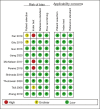Systematic review and meta-analysis of imaging differential diagnosis of benign and malignant ovarian tumors
- PMID: 35284306
- PMCID: PMC8899432
- DOI: 10.21037/gs-21-889
Systematic review and meta-analysis of imaging differential diagnosis of benign and malignant ovarian tumors
Abstract
Background: With the increasing incidence of gynecological ovarian tumors, the differential diagnosis of benign and malignant ovarian tumors is of great significance for subsequent treatment. Currently, ovarian examinations commonly use computed tomography (CT) or magnetic resonance imaging (MRI). This study sought to compare the value of CT and MRI in differentiating between benign and malignant ovarian tumors.
Methods: The PubMed, Cochrane Central Register of Controlled Trials, Embase, Web of Science, China National Knowledge Infrastructure, Wanfang, and Weipu databases were searched for published articles using the following terms "CT" or "Computed Tomography" or "MRI" or "Magnetic Resonance imaging" and "ovarian cancer" or "ovarian tumor" or "ovarian neoplasm" or "adnexal mass" or "adnexal lesion". The articles were screened and the data were extracted based on the inclusion and exclusion criteria. The Quality Assessment of Diagnostic Accuracy Studies-2 recommended by the Cochrane Collaboration was used to assess the methodological quality of the included studies, and the network meta-analysis was performed by Stata 15.0.
Results: The results showed that the overall sensitivity and specificity of CT were 0.79 [95% confidence intervals (CI): 0.70-0.87] and 0.87 (95% CI: 0.80-0.92), respectively. The overall sensitivity and specificity of MRI were 0.94 (95% CI: 0.91-0.95) and 0.91 (95% CI: 0.90-0.93), respectively. The area under the curve of the CT and MRI summary receiver operating characteristics were 0.9016 and 0.9764, respectively. The positive likelihood ratio, negative likelihood ratio, and diagnostic odds ratio of CT were 5.26 (95% CI: 2.78-9.93), 0.26 (95% CI: 0.13-0.50), and 22.19 (95% CI: 7.54-65.30), respectively. The positive likelihood ratio, negative likelihood ratio, and diagnostic odds ratio of MRI were 8.69 (95% CI: 5.06-14.92), 0.07 (95% CI: 0.04-0.13), and 146.19 (95% CI: 68.88-310.24), respectively.
Conclusions: Compared to CT, MRI has a stronger ability to differentiate between benign and malignant ovarian tumors. It's a promising non-radiological imaging technique and a more favorable choice for patients with ovarian tumors. However, in the future, large-sample, multi-center prospective studies need to be conducted to compare the performance of MRI and CT in distinguishing between benign and malignant ovarian tumors.
Keywords: Ovarian tumor; computed tomography (CT); differential diagnosis; magnetic resonance imaging (MRI).
2022 Gland Surgery. All rights reserved.
Conflict of interest statement
Conflicts of Interest: All authors have completed the ICMJE uniform disclosure form (available at https://gs.amegroups.com/article/view/10.21037/gs-21-889/coif). The authors have no conflicts of interest to declare.
Figures















Similar articles
-
Indirect comparison of the diagnostic performance of 18F-FDG PET/CT and MRI in differentiating benign and malignant ovarian or adnexal tumors: a systematic review and meta-analysis.BMC Cancer. 2021 Oct 6;21(1):1080. doi: 10.1186/s12885-021-08815-3. BMC Cancer. 2021. PMID: 34615498 Free PMC article.
-
Role of diffusion-weighted magnetic resonance imaging in differentiating malignancies from benign ovarian tumors.Int J Clin Exp Med. 2015 Nov 15;8(11):19928-37. eCollection 2015. Int J Clin Exp Med. 2015. PMID: 26884905 Free PMC article.
-
Diffusion weighted imaging for the differential diagnosis of benign vs. malignant ovarian neoplasms.Oncol Lett. 2016 Jun;11(6):3795-3802. doi: 10.3892/ol.2016.4445. Epub 2016 Apr 18. Oncol Lett. 2016. PMID: 27313697 Free PMC article.
-
Computed tomography vs liver stiffness measurement and magnetic resonance imaging in evaluating esophageal varices in cirrhotic patients: A systematic review and meta-analysis.World J Gastroenterol. 2020 May 14;26(18):2247-2267. doi: 10.3748/wjg.v26.i18.2247. World J Gastroenterol. 2020. PMID: 32476790 Free PMC article.
-
Comparison of magnetic resonance imaging and computed tomography in the diagnosis of acute pancreatitis: a systematic review and meta-analysis of diagnostic test accuracy studies.Ann Transl Med. 2022 Apr;10(7):410. doi: 10.21037/atm-22-812. Ann Transl Med. 2022. PMID: 35530935 Free PMC article.
Cited by
-
Diagnostic imaging of adnexal masses in pregnancy.Obstet Gynecol Sci. 2023 May;66(3):133-148. doi: 10.5468/ogs.22287. Epub 2023 Mar 10. Obstet Gynecol Sci. 2023. PMID: 36907575 Free PMC article.
-
Ovarian masses suggested for MRI examination: assessment of deep learning models based on non-contrast-enhanced MRI sequences for predicting malignancy.Abdom Radiol (NY). 2025 Mar 21. doi: 10.1007/s00261-025-04891-2. Online ahead of print. Abdom Radiol (NY). 2025. PMID: 40116887
-
The Impact of Surgery Delay on Early-Stage Ovarian Cancer.Life (Basel). 2025 Jan 17;15(1):122. doi: 10.3390/life15010122. Life (Basel). 2025. PMID: 39860062 Free PMC article.
-
The Discrepancy between Preoperative Tumor Markers and Imaging Outcomes in Predicting Ovarian Malignancy.Cancers (Basel). 2022 Nov 25;14(23):5821. doi: 10.3390/cancers14235821. Cancers (Basel). 2022. PMID: 36497302 Free PMC article.
-
An algorithm for the pre-operative differentiation of benign ovarian tumours based on magnetic resonance imaging interpretation in a regional core hospital: A retrospective study.Eur J Obstet Gynecol Reprod Biol X. 2023 Nov 15;20:100260. doi: 10.1016/j.eurox.2023.100260. eCollection 2023 Dec. Eur J Obstet Gynecol Reprod Biol X. 2023. PMID: 38058586 Free PMC article.
References
LinkOut - more resources
Full Text Sources
